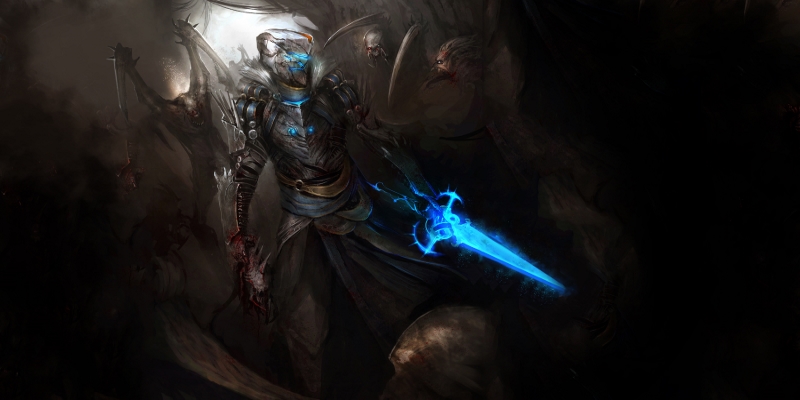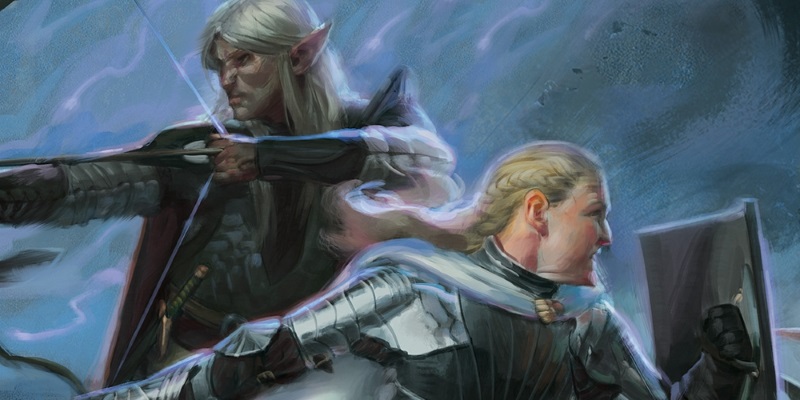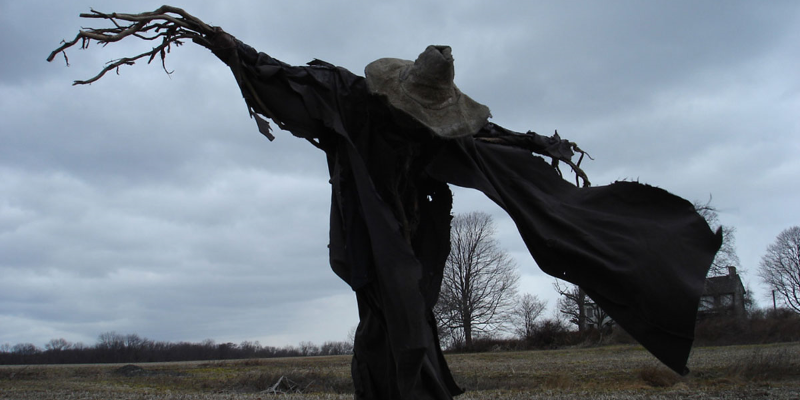Janusian Adventures

If you ask most people, they are glad to put 2016 in the rear-view mirror. People are looking to start fresh, kick old habits, and carve out a new story for themselves in the new year. However, the focus of the event is usually finding a good party to drink in the new year, and ensuring you have someone to intimately face-battle at the stroke of midnight. On the day itself, people wear new clothes, eat collards, and try to find white butterflies in order to set good luck trends for the year. Despite the traditions and superstitions that surround the start of a new year, precious little support is given to New Year’s in the special game one-shot area. Never fear, much like I was here for American Thanksgiving, I’m here for my boy Janus and his holiday.
It really is Janus we have to thank for the holiday, too. Despite January not being named for him (thanks, Juno…probably), Janus was an important god in the religion of Rome. He was the god of beginnings, doorways, portals, transitions, gates, time, exchanges, travelling, journeys, trading, and endings. Since he presides over the start and end of conflict, he was considered to have dominion over war and peace. He is usually depicted as having two faces, one looking into the future and one into the past. Interestingly, there wasn’t any clergy devoted specifically to Janus, as all clergy was expected to learn his rites as part of all other rites, owing to his place presiding over beginnings and ends. In a note I also like, animal sacrifice wasn’t associated with Janus, but rather offerings of spelt and salt were burned as gifts to him. I am pretty sure this means he needed to fight lots of ghosts… temporal ghosts. We can get into that below. Anyway, with this all in mind, it’s no surprise Janus is the deity that became associated with the new year.

Spacesea Half-Giants
You might need a new race if you want to play something with a tie to the time and space aspects of Janus and New Year’s traditions. Sure, the gith and slaad would be great choices, but what about spacesea giants? Janus would love some temporal arcane giants flying stone spaceships. Sure, they canonically worship Ptah (Egyptian space giants!), but Janus works. Half-giant is needed here to be fitting as a race, in my mind at least. This is all for fun, but that doesn’t mean I don’t take a holistic approach to design. If I produce it, I want it to be usable however you want to use it.
Ability Score Increase. Your Intelligence score increases by 2, and your Strength score increases by 1.
Age. As offspring of a race blessed by the gods to explore space-time, spacesea half-giants have long lifespans. A spacesea half-giant reaches adulthood around 25, and the oldest reach 300 years before discorporating into the stuff of the astral sea.
Size. Spacesea half-giants are between 6 and 8 feet tall, weighing between 220 and 300 pounds. Your size is medium.
Speed. Your base walking speed is 30 feet.
Spacesea Magic. You can cast meld into stone and stone shape with this trait, using Intelligence as your spellcasting ability for them. Once you cast either spell, you can’t cast it again with this trait until you finish a long rest.
Temporal Attunement. When you benefit from a teleport effect, you may teleport an additional distance up to your speed, provided you have any movement remaining. Once you have benefitted from this trait, you may not do so until you finish a long or short rest.
Gateway Guardian. You have advantage on ability checks to hold closed or open doorways that are being contested, and you may squeeze through openings without expending additional movement.
Full Circle. When you are the first or last in initiative order when initiative is rolled, you gain Inspiration. This Inspiration is lost when you are no longer threatened in combat. If you already possess Inspiration, you instead roll an additional 1d6 and add it to the result when rolling your Inspiration die. This additional 1d6 is lost when you are no longer threatened in combat.
Constant Gardner. You gain proficiency with the herbalism kit.
Languages. You can speak, read, and write Celestial, Common, and Giant.
Notes: It’s possible Full Circle could end up being too powerful, but I’d have to see it in action a lot. In my mind, it’s probably not likely you’d end up first or last a significant amount of the time you rolled initiative. If you choose to just act last, it wouldn’t trigger. If people choose to defer after you, it wouldn’t work. It’s possible you could build around this feature, but acting last has its own challenges, anyway. If it needed limiting, changing it to short or long rest would be fine. Temporal Attunement might not need the limitation, but I can imagine misty step getting out of hand pretty easily. It’s easy enough to change this one to no limitations. Luckily, any race can really participate in space-time content, but it doesn’t hurt to have an additional race to choose from.
Class Options
Despite Janus being the crux of the holiday, adding options for clerics doesn’t fit. Again, no clergy! For similar reasons, warlocks don’t really fit, either. I mean, they already have Great Old One patrons, so they don’t need much more than that. Instead, bards, fighters, and rangers are all fitting classes to which you could add some space-time-beginning-end class options.

College of Twin Paths (Bard College)
Bards of the College of Twin Paths know there are two sides to every story. For every road taken, there is another road that could have been traveled. Every time you open a door, another remains closed. These bards spin careful tales meant to shed new light on old classics, and perhaps even put a comic spin on a normally tragic tale. Truly skilled bards keep audiences spellbound by the uncertainty of their songs and stories.
The passion of bards of the College of Twin Paths is explore that which was cast aside, and to confront others about their choices, either to help them see the choice made was the correct one… or to cause regrets and lamentation where the bard feels it is deserved. The bards are not out to cause anguish, but to tell the whole tale.
Entwined
Upon joining the College of Twin Paths at 3rd level, you gain the ability to bind the fates of others together for a limited time. Whenever you give a target Bardic Inspiration, the target must select an ally or enemy they can see. When the Bardic Inspiration die is rolled, the chosen ally adds the result to the same action as the target performed that the ally performs before the end of the ally’s next turn. If an enemy is chosen, the enemy suffers the result as a penalty to the same action as the target performed that the enemy performs before the end of the enemy’s next turn.
Twisting Tale
Starting at 3rd level, you infuse your performance with the possibilities of all outcomes. If you perform for at least 10 minutes, you may attempt to alter the outcome of your audience’s future. At the end of the performance, choose a humanoid within 60 feet of you who watched and listened to all of it. You may provide fortune or misfortune. You may influence one target without consequence, but in order to provide the same to a second and third target, you must target another creature with the opposite for each additional use. The total number of targets may not exceed your Charisma modifier (minimum of 1). Each target of misfortune succeed on a Charisma saving throw against your spell save DC.
Fortunate targets gain Inspiration, which expires after they finish a long rest. If the target already possesses Inspiration, they may double their proficiency bonus for any single ability check, attack roll, or saving throw.
Targets with misfortune have fate turn against them at a crucial moment. If the target is visible to you, you may have the target make a single ability check, attack roll, or saving throw with disadvantage. If the target is not visible to you, and has not yet been forced by you to make a roll with disadvantage, the DM should determine when the target should suffer misfortune. The target’s misfortune fades after the target finishes a long rest.
Trade Route
At 6th level, you may enter into an agreement with another willing creature, temporarily confusing your fates. As a bonus action, select a creature you can see with 60 feet. If the creature is willing, you and the creature swap places, and each of you have resistance to all damage until the end of your next turn. However, any time either of you suffer damage during this period, the other suffers an equal amount of damage that ignores this resistance.
Once you have used this feature, you may not do so again until you finish a long or short rest.
Exchange Rates
Beginning at 14th level, you equivocate so well that actions become indistinguishable from each other. When you cast a bard spell, choose a number of targets equal to the level of the spell slot expended that are visible and within 60 feet of you. Add your Charisma modifier to the damage of each target’s next successful weapon attack made before the end of your next turn. If there are not enough targets available, you may double the granted bonus for a target instead of targeting an additional target. A target may only benefit from this bonus and additional bonus once per turn.
Alternatively, when you make a successful weapon attack, choose a number of targets equal to half your bard level (rounded down) that are visible and within 60 feet of you to add your Charisma modifier to the damage of their next spell of 1st level or above that successfully deals damage to a target before the end of your next turn. If there are not enough targets available, you may double the granted bonus for a target instead of targeting an additional target. A target may only benefit from this bonus and additional bonus once per turn.
After using either option, you may not use this feature again until you finish a long rest. When you give an ally Bardic Inspiration, roll 1d6. On a roll of a 6, you regain one use of the version of this feature that you did not use last.
Notes: I love the bard class. It’s probably my favorite class in this edition. Hopefully, I didn’t let it color my design. I was largely hoping to hew closely to the dual-aspects that Janus covers. Entwined double dips, but it doesn’t expand the core functionality of the Bardic Inspiration die. Further, the secondary target must act, or avoid acting, in the same manner as the original target. I think the limitations are enough, here. Twisting Tales is more of a discussion point, as it is a bit odd. I am all for things triggering Inspiration, as anecdotally I hear people lamenting its under utilization. It also strikes a bargain between DM-fiat and player choice with the second portion. I think Janus would approve. Trade Route is pretty straight forward. Exchange Rates is a bit more complex, but I think it ends up alright. The damage potential is high, but each case requires resources, and re-use is random or once per day. It could go all in favor of the bard, but that’s pretty unlikely. Lowering the targets, maybe to your proficiency bonus, is an option, of course. I think it’s mostly ok. High-level play is more about control than pure damage, anyway.

Infiknight (Fighter Archetype)
The multiverse is a vast place filled with limitless possibilities and equally as many versions of yourself…according to the philosophy of the infiknights, at least. Infiknights sequester themselves in sky towers, large structures reaching towards the heavens, and practice meditation and mindfulness, blending them with their martial pursuits. As they expand their consciousness, they are allowed higher within the tower, until they finally reach the top and become one with the multiverse. No one outside the infiknight orders is certain if this last piece if metaphorical or literal, as the infiknights do not speak of their practices.
Self Discovery
Beginning when you choose this archetype at 3rd level, you sense the presence of your other selves in the multiverse. You can tether yourself across space-time with a number of your selves equal to half your fighter level (rounded down). You may call upon the experience of your other self, breaking the tether to that self, to perform any of the following abilities:
- When you are hit with a weapon attack, you can spend a reaction and break a tether to increase your AC by your proficiency bonus against that attack.
- When you successfully hit with a weapon attack, you can spend a bonus action and break a tether to deal an additional 1d8 psychic damage. You may break multiple tethers when you perform this bonus action, each additional tether adding 1d8 psychic damage.
- As a bonus action, you can break a tether to double your proficiency bonus when performing an ability (skill) check in which you are proficient.
- As a bonus action, you can break a tether to become proficient in a skill or tool for one hour. If you use this feature again while you are currently benefiting from it, you lose the proficiency in the previous skill or tool you selected.
- As an action, you can break a tether to gain resistance to all damage and advantage on your next attack roll, expiring at the end of your next turn.
Your tethers return in full after you finish a long rest. Whenever you take a short rest, you may expend a hit die to roll a 1d4. You regain tethers equal to the result, up to your maximum amount of tethers.
New Me
When you select this archetype at 3rd level, you can select a skill in which you are proficient, and exchange it for proficiency in a different skill. You may select any skill, regardless of whether you would normally be able to select it.
You also gain proficiency in a new skill from the list of fighter skills you have not selected, but only half of your proficiency bonus (rounded down) is applied to checks using this skill.
In Another Life
Starting at 7th level, select one 1st-level spell from any spell list. You can cast this spell using either Strength or Dexterity as your spellcasting ability, chosen at the time you select this spell. You cast this spell using the action appropriate to the spell. Once you have used this feature, you cannot do so again until you finish a long rest. You may break a tether to use this feature again without resting. You may also break a tether for each level of spell slot you wish to increase the spell.
One Life to Live
Upon reaching 10th level, your connections to your other selves strengthen your life force. Whenever you fail a death saving throw, you may break a tether to reroll the saving throw. If you have no tethers remaining, you have advantage on your death saving throws.
The One
Beginning at 15th level, you have expanded your consciousness to become the only version of you in existence for a short time, perceiving space-time to allow such a thing to be possible. When you roll initiative, you can decide to forego breaking any tethers for 1 minute. If you have no tethers remaining, you cannot use this feature. You gain advantage on Dexterity and Strength checks and saving throws. Whenever you deal weapon damage with an attack, roll 1d6 and add the result to the damage roll of the attack. Further, when you would take damage, you can spend your reaction to gain resistance to the damage being dealt. These benefits expire after 1 minute.
Once you have benefited from this feature, you cannot do so again until you finish a long rest.
Notes: Cosmic zen warriors seeking perfection isn’t just for monks. This is really a combination of Jet Li’s The One and the Planescape faction Believers in the Source. I’m always down for a path to apotheosis, regardless of class. The limiter in the class is the tethers, which can be spent for combat and non-combat actions. This is essentially per short rest at low levels, and less so at higher levels. The damage component lacks scaling in terms of die size, but scales in overall number as you accrue higher levels, and gives you some pretty stellar burst. It’s not precisely smiting, as it requires a bonus action, and action economy does matter for fighters, for sure. I don’t think it’s too much, but it’s easy to scale down the damage or limit it to once per attack. New Me gives some added skill flexibility, as I wanted non-combat to get some good service with the archetype. In Another Life is limited by resource and by resting. It’s a fun skill meant to go to theme, more than anything. One Life to Live is double lifting with theme. You can “kill off” your other selves to save yourself, but if you are the last remaining, you are more you than ever before. The One exchanges resource flexibility for resource, and is combat prowess focused. Overall, I think it’s probably ok, as far as first pass balance goes.

Temporal Warden (Ranger Archetype)
Understanding of space-time leads some to abuse it to their own ends, or for nefarious purposes. The temporal wardens ensure this does not occur, catch those responsible, and face the creatures that come into being as a result of space-time anomalies. The organization of Temporal Wardens mirrors that of traditional peacekeeping forces.
Necessary Force
When you select this archetype at 3rd level, you learn how to fight your most common foes: those that manifest as a result of altering or rewriting time. The more drastic the alteration, the more powerful the resulting anomaly. These anomalies can take many forms, but the most common manifestation is the time ghost.
You gain the following benefits:
- Once per attack, whenever you roll the maximum or minimum result on a damage die, you may roll the die again, adding the new result to the damage total.
- When a creature resists damage that you deal, you deal an additional 1d8 force damage to it.
- Whenever you successfully hit a creature, it must succeed on a Wisdom saving throw against your spell DC or suffer an additional 1d8 force damage if it attempts to hide or turn invisible before the start of your next turn. Only one creature may be affected by this portion of the feature at a time.
Both portions of the damage increase to 2d8 at 5th level, 3d8 at 11th level, and 4d8 at 17th level.
In Hot Pursuit
At 3rd level, you learn how to chase down your targets. One of the major duties of a Temporal Warden is the pursuit and apprehension of space-time adversaries. To that end, you gain the following:
- When you reduce a creature to 0 hit points, you can bind the creature in radiant lock and chains as a bonus action. The chains impose disadvantage on any attempt to break the lock and chains or pick the lock. The chain has 20 hit points and the DC to burst the chain or pick the lock is 15. You may bind creatures equal to your Dexterity modifier (minimum of 1) at any time. Both the hit points of the chain and the DC to burst the chain or pick the lock increase by 5 at 5th level, and again at 11th level and 17th level.
- Whenever a creature you attacked on your last turn ends its turn farther away from you, you can roll a 1d4 and add the result to your attack rolls against the creature on your next turn.
- Whenever a creature teleports, you can spend your reaction to make a weapon attack against the creature prior to its teleportation completing, with advantage.
Slipstream
Beginning at 7th level, you have learned how to manipulate space-time to your advantage. Whenever you take the Dash or Disengage action, you may teleport an additional distance equal to half your speed. Additionally, you may make a single attack after completing either of these actions.
Salt and Sanctuary
Starting at 11th level, you have learned how to protect yourselves from time ghosts, and make yourself more effective at their destruction. It also assists you against other targets, to varying degrees.
As a bonus action, you can cast protection from evil and good on yourself without any components, and without requiring concentration. While you benefit from this spell, you have advantage on Investigation and Perception checks. Additionally, when you take damage from a creature proscribed by the spell, you can spend your reaction to gain resistance against the damage.
As a bonus action, you may wreathe your weapon in force for 1 minute. You gain a +1 bonus to attack rolls, and your successful attacks deal an additional 1d6 force damage.
You may use both of these abilities a combined number of times equal to your Dexterity modifier (minimum of 1). Once you have done so, you must finish a long rest before being able to use this feature again, at which time all uses return.
Non-Linear
Upon reaching 15th level, you achieve a level of mastery over the space-time continuum. When you finish a long rest, roll 1d6. You can change the outcome of certain events a number of times equal to the result. When you miss an attack, fail a saving throw, fail against the DC of an ability check, or have an attack hit you, you can instead alter events to have the opposite occur instead. However, you must allow the opposite result to occur before your next long rest, or face a paradox. For each result you do not cancel with an opposite result, you lose one hit die, take 10 force damage that cannot be prevented or reduced by any means, and suffer one level of exhaustion upon finishing the long rest.
When you complete a short rest, roll 1d6. On a 6, you gain another use of this ability.
Notes: I find working with ranger difficult, at best. I am working with the published model here, and a UA version of this archetype would look very different, by necessity. Anyway, you are a time ranger. It’s pretty straightforward. You battle the aforementioned time ghosts (why else would Janus want so much salt?), and pursue time criminals. Fun hijinks for a day devoted to a god of myriad outcomes. The first few abilities pack a lot into them, but they are very specific with one general use feature each. Corner case coolness, but not ridiculous, and in general you get by. Some of these abilities could be empowered or removed, as the case is needed, of course. Slipstream gives you a little extra Best Movement, and lets you get a shot off. Your deal is pursuing criminals, after all, so I thought it fitting. Either part could be reasonably dropped, as needed, again. Salt and Sanctuary lets you cast some spells for free (and get around the SRD), but is limited per day. They are pretty solid features, so the limit is dead on, I feel. The damage of the second part doesn’t scale on its own, but works with multiple attacks so I think it’s ok. Finally, Non-Linear is a weird one, but come on, we HAD to have something about paradoxes! It gives the player something akin to a legendary action, but one they had better offset if they want to keep themselves healthy. I’m ok with people performing kind of chintzy things to offset it, I mean, that’s what you would see in a narrative. Of course, letting yourself fail isn’t the same as actually failing, something that the protagonists would learn in due time. I think the theme here is pretty strong, which is good. The abilities probably hold up, but likely needs some iteration.
Rage Against the Auld Lang Syne
In conclusion, I hope this helps inspire you to consider some New Year’s and Janus-inspired holiday one-shot fun. These might be a bit silly, but when else but the holidays can you let your hair down and try out some zany shenanigans? That’s what this is all about. So, kick off the New Year with a new tradition, a first of the year one-shot all about appeasing and honoring that weirdo god Janus. We do it in our own ways to this very day. Why not on a tabletop?



